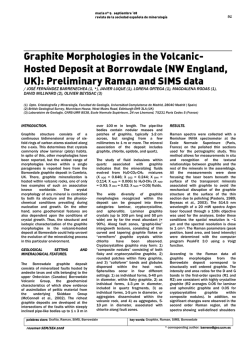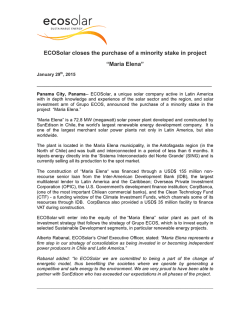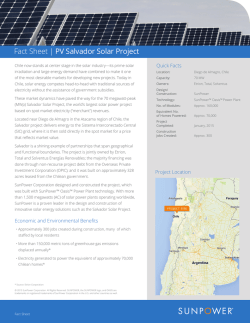
Study and Analysis on Synthesis of Graphene and its Applications in
International Journal of Innovative Research in Advanced Engineering (IJIRAE) Issue 1, Volume 2 (January 2015) ISSN: 2349-2163 www.ijirae.com Study and Analysis on Synthesis of Graphene and its Applications in Solar Cells Dr. Magan P. Ghatule* Sinhga Academy of Engineering, Kondhwa (Bk), Pune-48. Ulka A. Devare Sou. Venutai Chavan Polytechnic, Ambegaon (Bk), Pune-41. Abstract: The single-atom-thick carbon allotrope graphene has been adorned as a "marvelmaterial". Its properties like high thermal conductivity, high Young’s modulus, large specific surface area, electromagnetic interference shielding, and electrical conductivity has made it as one of the most attractive materials in more and more research fields . While conducting heat and electricity its unique ability to be flexible, yetstrong and light all better than typically used materials. It has provided scientists and engineers with countless research and development opportunities. In this paper brief review and motive on recent significant advances in the synthesis of graphene and its applications in solar cell architecture as transparent layers, active layer and electrodes is presented. Keywords: Graphene , Nanomaterials , Solar cells , Electrodes. I.INTRODUCTION Recently, the emerging need for high-speed electronics and energy has motivated researchers to discover, develop and assemble new classes of nanomaterial in unconventional device architectures. Carbon nanomaterials composed entirely of sp 2 bonded graphitic carbon.[1]Graphene, as the youngest member of the noticeable carbon family, is the name for a single layer of graphite and is considered as the basic unit for all other members of carbon family.[2]Derived from graphite, graphene is a two-dimensional planar honeycomb structure made out of hexagons. The unit cell for graphene consists two carbon atoms, which generates two pbands, a p-band and a p*band. The two bands touch each at the K-point in the hexagonal first - Brillouin zone and remain equal in energy for symmetry reasons. So, graphene is a semi metal or zero-gap semiconductor, combining metallic and semiconducting characteristics.[3] Graphene has many extraordinary electrical, mechanical, and thermal properties, such as high carrier mobility, ambipolar electrical field effect, tunable band gap, room temperature quantum hall effect, high elasticity, superior thermal conductivity and so on.[4]Graphene’s structure, including being single-atom thick, two-dimensional and completely conjugated accounts for its unique properties..To fully utilize the superior properties of graphene, fabrication of graphene composites with other functional materials is another important topic for researchers.Modified graphene materials have been used in solar cells.Owing to the great potential for transparent and conductive electrodes in solar cells, graphene has been widely studied as different parts of solar cells in terms of their low cost, flexibility and high efficiency.[5] II. METHODS AND MATERIALS There are two main schemes for the synthesis of graphene initiated from different carbon sources; the ‘top-down’ and ‘bottom-up’ methods are to be considered. . III. TOP DOWN METHOD The top-down approach is widely used for graphene synthesis in large quantity and the resulting grapheme nanosheets can be conveniently complexed with other functional components to fabricate novel materials.[6] The most popular top-down method is via the oxidative exfoliation of graphite.[7]Thermal expansion of graphite oxide is a useful method for the Fig. (1) : Graphene structure: Hexagonal lattice. Red and green colors indicate the two triangular sub lattices. [5] ____________________________________________________________________________________________________________ © 2015, IJIRAE- All Rights Reserved Page - 184 International Journal of Innovative Research in Advanced Engineering (IJIRAE) Issue 1, Volume 2 (January 2015) ISSN: 2349-2163 www.ijirae.com unzipping of CNTs resulted in elongated graphene strips by using acid reactions, plasma treatment, liquid NH3 and Li intercalation– exfoliation and catalytic approaches.[13-16]Electrochemical oxidation to accurately control the degree and synthesis of functionalized single-layered graphene.[8]An electrochemical method to reduce graphene oxide under constant potential.[9]The radiation-induced reduction of graphene oxide by using sunlight, UV light and KrFexcimer laser.[10]Apart from these exfoliation methods, high-yield graphene with good quality was also prepared via the exfoliation–reinteraction–expansion of graphite, where graphite was treated with oleum without excessive chemical functionalization.[11]There is also a more facile method for the exfoliation of graphite oxide by using laser excitation other than using any chemical reducing agent.[12]The chemical sites of oxidation under ambient conditions with the unique advantage of thickness and orientation control.[17]Ultrashort laser pulses to detach graphene monolayers from graphite, one at a time.[18]Photo-exfoliation should be able to produce intact graphene monolayers free of contaminants and defects at a high rate. Laserinduced melting of graphite under different pressure conditions.[19]The firstly introduced H2O2 plasma technique is an easy and environmental friendly method although the yield, as yet, is not high enough.[20]Top-down method is widely used for synthesis of graphene. The disadvantages of this method are use of risky and terminal reagents. Again the synthesized graphene contains large number of defects which limits its applications. III. BOTTOM UP METHOD The bottom-up approach starting from small organic molecules is another important method for precise control over the morphology and structure of graphene. It has been well documented that the decomposition of hydrocarbons into graphitic materials can be catalyzed by metal surfaces through chemical vapor deposition (CVD).[21]The control in graphene scale makes CVD the most attractive method for devices fabrication.[22]A new route to large-scale synthesis of high-quality graphene films was demonstrated by using centimeter-scale Cu substrates. This cost- and time-effective roll-to-roll production method resulted in 30-inch graphene films and simultaneously provided an efficient synthesis of graphene with large scale and good quality for practical application.[23]Another common method for graphene synthesis is the epitaxial growth of graphene on SiC wafer surfaces through the decomposition of SiC followed by the desorption of Si from the surface.[24]Fascinatingly an organic synthesis method for graphene has also put forward, in which precursors are those discotic aromatic hydrocarbons with precise chemical structures and functional groups.[25]The bottom-up approach introduces much less defects on the graphene surfaces as compared the top-down approach. IV. APPLICATIONS IN SOLAR CELL As an ideal 2D material that can be assembled into film electrodes with low roughness, high conductivity and large surface area thin graphene films are often used as window or/and counter electrodes, electron and hole transport materials and buffer layers in solar cells.[26]The subsequent thermal reduction of graphene nanosheets led to a great increase of the conductivity and the overall power efficiency of 1.12% of the solar cells. Apart from DSSC, graphene has also been used in organic solar cells.[27] Compared with indium tin oxide (ITO) which suffers from rising cost and brittleness, graphene has many advantages in terms of its low cost, transparency, chemical robustness, flexibility and high electrical conductivity.[28]The high-performance organic solar cells by interface engineering of layer-by-layer stacked graphene anodes is also reported. Besides acting as a transparent conductive electrode, graphene has other potential uses for photovoltaic devices. For instance, through incorporation into conjugated polymers, graphene has largely improved the exciton dissociation and charge-transport properties. The organic solution-processed graphene material has been applied as an electron acceptor in organic bulk heterojunction (BHJ) photovoltaic devices with P3HT and P3OT as electron donor.[29,30] By controlling annealing, the device performance can be improved considerably. V. CONCLUSION In summary of the paper two method, both of which have their advantages and disadvantages,the bottom-up approach introduces much lessdefects on the graphene surfaces as compared the top-downapproach, but the method is relatively more difficult and budgetshigh . It is still needed to developnew methods or make some improvements on these knownmethods for the preparation of high-quantity and high-qualitygraphenenanomaterials. Also graphene-based materials are appropriate for photoconversion due to their strong light absorption, high charge mobility, good stability .Organic photovoltaic devices were also fabricated by using graphenebased materials. The key for the further improvement in PCE is to reduce the sheet resistance of graphene, which can be achieved by increasing the carrier mobility via interface control or by more effective doping. REFERENCES 1 A. K. Geim and K. S. Novoselov,The rise of graphene, Nat. Mater., 2007, 6, 183. 2. Liping Huang, Bin Wu, Gui Yu and Yunqi Liu*Journal of Materials Chemistry,2010 ,10.1039/c0jm02225j. 3. Du X, Skachko I, Duerr F, Luican A and Andrei E Y 2009 ,Fractional quantum Hall effect and insulating phase of ,Dirac electrons in grapheneNature 462 192. 4 C. Lee, X. Wei, J. W. Kysar and J. Hone,Measurement of the elastic properties and intrinsic strength of monolayer graphene, Science, 2008, 321, 385. ____________________________________________________________________________________________________________ © 2015, IJIRAE- All Rights Reserved Page - 185 International Journal of Innovative Research in Advanced Engineering (IJIRAE) Issue 1, Volume 2 (January 2015) ISSN: 2349-2163 www.ijirae.com 5 Eva Y Andrei, Guohong Li1 and XuDu ,Electronic properties of graphene: a perspective from scanning tunneling microscopy and magnetotransport , Rep. Prog. Phys. 75 ,2012, 056501. 6 Guixia Zhao, Tao Wen, Changlun Chen and Xiangke Wang, RSC Advances, 2012, 2, 9286–9303. 7 Hummers and R. E. Offeman, J. Am.Preparation of Graphitic Oxide Chem. Soc., 1958, 80, 1339–1339. 8 H. C. Schniepp, J.-L. Li, M. J. McAllister, H. Sai, M. Herrera- Alonso, D. H. Adamson, R. K. Prud’homme, R. Car, D. A. Savilleand I. A. Aksay,Functionalized Single Graphene Sheets Derived from Splitting Graphite Oxide, J. Phys. Chem. B, 2006, 110, 8535–8539. 9 X.-Y. Peng, X.-X. Liu, D. Diamond and K. T. Lau,Functionalized Single Graphene Sheets Derived from Splitting Graphite Oxide Carbon, 2011, 49, 3488–3496. 10 C. N. R. Rao , A. K. Sood , K. S. Subrahmanyam and A. Govindaraj , Graphene: The New Two-Dimensional Nanomaterial,Angew Chem., Int. Ed., 2009, 48, 7752–7777. 11 X. Li, G. Zhang, X. Bai, X. Sun, X. Wang, E. Wang and H. Dai,Highly conducting graphene sheets and Langmuir–Blodgett films, Nat. Nanotechnol., 2008, 3, 538–542. 12 V. Abdelsayed, S. Moussa, H. M. Hassan, H. S. Aluri, M. M.Collinson and M. S. El-Shall, PhotothermalDeoxygenation of Graphite Oxide with Laser Excitation in Solution and Graphene-Aided Increase in Water Temperature ,J. Phys. Chem. Lett., 2010, 1, 2804– 2809. 13 D. V. Kosynkin, A. L. Higginbotham, A. Sinitskii, J. R. Lomeda.A. Dimiev, B. K. Price and J. M. Tour, Longitudinal unzipping of carbon nanotubes to form graphenenanoribbons ,Nature, 2009, 458, 872–876. 14 L. Jiao, L. Zhang, X. Wang, G. Diankov and H. Dai,Narrow graphenenanoribbons from carbon nanotubes, Nature, 2009, 458, 877– 880. 15 A. G. Cano-Ma´rquez, F. J. Rodı´guez-Macı´as, J. Campos-Delgado, C. G. Espinosa-Gonza´ lez, F. Trista´n-Loo´pez, D. Ramı´rezGonza´ lez, D. A. Cullen, D. J. Smith, M. Terrones and Y. I. Vega-Cantuu´ , Ex-MWNTs: Graphene Sheets and Ribbons Produced by Lithium Intercalation and Exfoliation of Carbon Nanotubes ,Nano Lett., 2009, 9, 1527–1533. 16 A. L. Elı´as, A. s. R. Botello-Me´ndez, D. Meneses-Rodrı´guez, V. Jehova´ Gonza´ lez, D. Ramı´rez-Gonza´ lez, L. Ci, E. Mun˜ozSandoval, P. M. Ajayan, H. Terrones and M. Terrones,Longitudinal Cutting of Pure and Doped Carbon Nanotubes to Form Graphitic Nanoribbons Using Metal Clusters as Nanoscalpels , Nano Lett., 2010, 10, 366–372. 17 D. B. Shinde, J. Debgupta, A. Kushwaha, M. Aslam and V. K. Pillai, J. Am.Electrochemical Unzipping of Multi-walled Carbon Nanotubes for Facile Synthesis of High-Quality GrapheneNanoribbons, Chem. Soc., 2011, 133, 4168–4171. 18 Y. Miyamoto, H. Zhang and D. Toma´nek, .Photoexfoliation of Graphene from Graphite: An Ab Initio Study ,Phys. Rev. Lett., 2010, 104, 208302. 19 M. E. Garcia and H. O. Jeschke,Theoretical approach to the laser-induced melting of graphite under different pressure conditions, Appl. Surf. Sci., 2003, 208–209, 61–70. 20 G. Zhao,D. Shao, C. Chen and X. Wang, Synthesis of few-layered graphene by H2O2 plasma etching of graphite , Appl. Phys. Lett., 2011, 98, 183114. 21 B. Zhang, W. H. Lee, R. Piner, I. Kholmanov, Y. Wu, H. Li, H. Ji and R. S. Ruoff,Low-Temperature Chemical Vapor Deposition Growth of Graphene from Toluene on Electropolished Copper Foils, ACS Nano, 2012, 6, 2471–2476. 22 M. Xu, D. Fujita, K. Sagisaka, E. Watanabe and N. Hanagata, Production of Extended Single-Layer Graphene , ACS Nano, 2011, 5, 1522–1528. 23 S. Bae, H. Kim, Y. Lee, X. Xu, J. S. Park, Y. Zheng, J. Balakrishnan, T. Lei, H. R. Kim, Y. I. Song, Y.J. Kim, K.S.Kim, B. O¨ zyilmaz, J.H. Ahn, B.H. Hong and S. lijima,Roll-to-roll production of 30-inch graphene films for transparent electrodes , Nat. Nanotechnol., 2010, 5, 574–578. 24 W. A. De Heer, C. Berger, X. Wu, P. N. First, E. H. Conrad, X. Li, T. Li, M. Sprinkle, J. Hass and M. L. Sadowski,Epitaxial graphene, Solid State Commun., 2007, 143, 92–100. 25 X. Wang, L. Zhi and K. Mu¨ llen,Two-Dimensional GrapheneNanoribbons, Nano Lett., 2008, 8, 323–327. 26 J. K. Wassei and R. B. Kaner, Transparent, Conductive Graphene Electrodes for Dye-Sensitized Solar Cells ,Mater. Today, 2010, 13, 52–59. 27 H. Park, J. A. Rowehl, K. K. Kim, V. Bulovic and J. Kong,Doped graphene electrodes for organic solar cells , Nanotechnology, 2010, 21, 505204. 28 Y. Wang, S. W. Tong, X. F. Xu, B. O¨ zyilmaz and K. P. Loh, Interface Engineering of Layer-by-Layer Stacked Graphene Anodes for High-Performance Organic Solar Cells , Adv. Mater., 2011, 23, 1514–1 . 29 Z. Liu, Q. Liu, Y. Huang, Y. Ma, S. Yin, X. Zhang, W. Sun and Y. Chen, Organic Photovoltaic Devices Based on a Novel Acceptor Material: Graphene ,Adv. Mater., 2008, 20, 3924–3930. 30 H. A. Becerril, J. Mao, Z. Liu, R. M. Stoltenberg, Z. Bao and Y. Chen,Evaluation of Solution-Processed Reduced Graphene Oxide Films as Transparent Conductors, ACS Nano, 2008, 2, 463–470.518. ____________________________________________________________________________________________________________ © 2015, IJIRAE- All Rights Reserved Page - 186
© Copyright 2025





